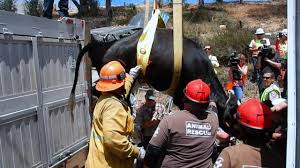SMART (Specialized Mobile Animal Rescue Team)
Officer Armando Naverette
 SMART is the first Specialized Mobile Animal Rescue Team. It was created because there was a demand for a team dedicated to rescuing animals stuck in extreme situations. Members of SMART combined their passion for rescuing animals with their recreational knowledge and experience of rock climbing and rappelling. Officer Armando Naverrete is our guest to talk about some of his most unusual rescues.
SMART is the first Specialized Mobile Animal Rescue Team. It was created because there was a demand for a team dedicated to rescuing animals stuck in extreme situations. Members of SMART combined their passion for rescuing animals with their recreational knowledge and experience of rock climbing and rappelling. Officer Armando Naverrete is our guest to talk about some of his most unusual rescues.
Rock climbing was a hobby of Armando Naverette because it was a fun outdoor activity. When he started in this job back in 1997, he knew they were going to be rescuing animals but found that there was no training. So he thought if he can climb rocks, how hard would it be to climb buildings or trees. Of course he didn't have the right training or ropes, so it was kind of trial and error but luckily he's still here to talk about those trials. However, the SMART Team has made many advances since they started.
So what does the SMART Team actually do? Armando tells us that they rescue any type of animal; domestic or wildlife, owned or not owned, vicious or not vicious, cute or ugly, four legged, three legged, furry not furry or slimy type of critter, it doesn't matter. They will rescue any animal that's in distress. This means if it's stuck somewhere where the regular animal control officers can't get to him, or even in some cases where fire personnel say, "It's an animal, we don't deal with that so we're going to pass it on to you," the SMART team will go after it. They have successfully rescued all of the animals they have gone after.
Armando always tells people when they join the team that they have to be ready for Mission Impossible, because every rescue they've come upon is never textbook. Even though they've done something similar, it's never like, "Oh that one's an easy one. We've done it before." So some of the more dangerous ones are the high elevation ones, because they're putting people in trees, like a tree trimmer, except they're not going to be going after a branch that they're going to cut, they're actually going after an animal that has a fight or flight mentality. These animals can either go higher or even attempt to jump. So for the rescuers, maybe one of the main climbers, it's very difficult and dangerous because you're putting everything on the line on a rope and usually a branch. The team is trained to minimize the risk. So far they've been very good at not getting into any big trouble because of their training. Every rescue has its danger level, some more some less, but they're all dangerous.
 Everyone asks Armando what's the craziest situation that he's rescued an animal from. He always has an answer for it, because every rescue they do seems to top the last one. He might say last week or last month was crazy because they had to rescue two cows who were trapped in an overturned trailer on the freeway. But now that crazy rescue gets topped by the rescue of a pet chameleon who was five stories up on a building. It had been there for four days and they had to send people to repel over the side of the building to get a little pet chameleon that was very cooperative. So he always has an answer for, "What's your craziest rescue story," and always has one that tops the next one.
Everyone asks Armando what's the craziest situation that he's rescued an animal from. He always has an answer for it, because every rescue they do seems to top the last one. He might say last week or last month was crazy because they had to rescue two cows who were trapped in an overturned trailer on the freeway. But now that crazy rescue gets topped by the rescue of a pet chameleon who was five stories up on a building. It had been there for four days and they had to send people to repel over the side of the building to get a little pet chameleon that was very cooperative. So he always has an answer for, "What's your craziest rescue story," and always has one that tops the next one.
People are surprised when they hear that their tax dollars actually sent a team out to rescue a chameleon. But think about it. The fire department loves the SMART team because most people think of their animals as a family member. These people will go out there and try to rescue their pet themselves, which now puts them in danger. Then the fire department has to go out and rescue those people. And the fire department won't go out with one or two people, they will go out with 20 to 30 people, depending upon the size of the animal and location. So SMART is actually saving the city money by having a small unit.
 Armando wishes that he could take all of his crew to every rescue, but the reality is people have their lives and they have other jobs. So he's lucky if he gets three or four of their top notch rescuers to respond to any one rescue.
Armando wishes that he could take all of his crew to every rescue, but the reality is people have their lives and they have other jobs. So he's lucky if he gets three or four of their top notch rescuers to respond to any one rescue.
It's not that they make a lot of money doing this either, so they do what they can and it is taxpayer's money, but it's also a great service that they provide the citizens of Los Angeles along with the big pet community. However it still takes a lot of money to do these rescues. Therefore, they have a pretty extensive wish list. Everything on that list is important because they do have a budget. But being a government agency, budgets can fluctuate from zero to a couple hundred dollars to a few thousand. But it's always one of those things that can get cut immediately because the funds need to go somewhere else. So they need to have this kind of wish list out because the equipment they have has a lifespan. If it gets used a certain amount of times, they have to either discard it or replace it. So the wish list is something that they really hope that people will say, "Well, I'll buy you one of those," because just one of those items means a lot to their team.
Visit Website
Fear Free Now Certifying Trainers
Mikkel Becker, Certified Dog Trainer
 As the Fear Free movement explodes, dog trainers can now become certified using methods that make the learning experience more appealing to the dog. Finding a Fear Free Dog Trainer has become easier using the online database. Mikkel Becker tells us how Fear Free makes a difference in behavior training.
As the Fear Free movement explodes, dog trainers can now become certified using methods that make the learning experience more appealing to the dog. Finding a Fear Free Dog Trainer has become easier using the online database. Mikkel Becker tells us how Fear Free makes a difference in behavior training.
The Fear Free movement is trying to make veterinary care more like pediatric dentistry or pediatric medicine. This has changed so much from when we were younger and many of us were manhandled and manipulated, threatened and abused. Now, these offices are geared towards children to make them comfortable and relaxed to where they actually enjoy going. This is what they are trying to do for our pets.
The Fear Free Happy Homes movement is set to do two things. One is to reduce fear anxiety and stress in the home. The other thing is to increase enrichment activities.
Now, we have Fear Free Certified Trainers. It's directed primarily towards dogs and cats. However, the Fear Free Certified Training Course really encompasses all species. The course is for trainers that have gone through certain educational courses or have a certain level of certification. This is done for the veterinary professionals who partner with the Fear Free animal trainer as well as for pet parents. This allows them to find a trainer who has those credentials and allows them to separate them from maybe those who don't have the same level of knowledge or the same type of commitment to protecting the pet's emotional well-being. That's one of the main reasons that they really wanted to find trainers that they could train in Fear Free, but who were also already at the level that they really wanted and knew that pet owners could trust.
So what sort of pet owners should seek out professional training? Mikkel tells us that all pet owners should think about professional training. She states that training is very beneficial both preventively and also if you're dealing with an issue. Preventively, when you look at Fear Free, it's much better if you can teach your dog, your cat, your pig, or your bird, whatever it is that you have, to enjoy veterinary care and home husbandry care. This includes things like giving medication or just doing normal grooming and making everything positive from the start. So both preventively, but also if you're dealing with issues and you already have fear, anxiety and stress, the time is now, whether it's something that you do early on or if you're already tackling an issue.
 How does the Fear Free message make a difference in training and behavior? Mikkel explains that it makes a huge difference because it's all about both the physical and the emotional well-being of pets. In the past, there has been some separation between veterinary professionals and trainers and the Fear Free Course encompasses both. It takes both those reputable trainers and veterinary professionals and merges them together. This enables them to form a collaboration and a partnership where pet owners are better served because their animals are receiving care both for their physical well-being through veterinary care and also their emotional well-being.
How does the Fear Free message make a difference in training and behavior? Mikkel explains that it makes a huge difference because it's all about both the physical and the emotional well-being of pets. In the past, there has been some separation between veterinary professionals and trainers and the Fear Free Course encompasses both. It takes both those reputable trainers and veterinary professionals and merges them together. This enables them to form a collaboration and a partnership where pet owners are better served because their animals are receiving care both for their physical well-being through veterinary care and also their emotional well-being.
So how can you find a certified trainer? Mikkel says go to FearFreePets.com where you will find a searchable directory. You can then search by the professional type, whether you want a trainer or if you need a veterinary professional. You can also search by your location and find those that are closest to you.
If you are an animal trainer and would like to become Fear Free Certified, you can also go to FearFreePets.com to find information about the course.
Mikkel is very excited about this new course and says it has been months in the making. It has been a collaboration with a lot of really highly skilled professionals and there's some really good content for everyone.
Mikkel has many training tips and gives one of her favorite tips for pet owners. She says one of the best things that you can do when you are grooming your pet, whether it is a dog or a cat, is to have a non-slip surface on the bottom of the sink or the tub where you're bathing your pet. Whenever a pet slides and slips, it's really scary for them. One of the easiest ways to make bath time less frightening is to have a non-slip surface underneath them, which will make them feel a lot more comfortable and calm.
Visit Fear Free Happy Homes for tips on making your home fear free and to locate a Fear Free Veterinarian near you. Go to Fear Free Pets to become certified.
Listen and Explore the Fear Free Expert Series
Who Gets Custody Of The Dog?
Jeremy Cohen, Boston Dog Lawyer
 Attorney Jeremy Cohen gave up his job prosecuting those accused of insurance fraud. He found it unfulfilling. Now, he represents dogs. He'll share the details of several current cases that involve custody battles over pets.
Attorney Jeremy Cohen gave up his job prosecuting those accused of insurance fraud. He found it unfulfilling. Now, he represents dogs. He'll share the details of several current cases that involve custody battles over pets.
So what kind of cases does he represent? Jeremy states his practice grows every day. With every phone call there's a new dog-related issue. Right now custody cases are big. This is where people were living together, split up and now they have a debate over who should take care of the dog or cat. Thirty years ago custody of a pet was not a problem. While couples still broke up, it wasn't much of an issue if one of them wanted the dog or the cat. He's also handling a lot of negligence cases. These include wrongful injury or wrongful death of a pet caused by a third party. He claims those are real difficult to hear about, but he listens. He is also trying to see if he can do something that other people haven't been able to do, which is to have our pets be considered more than just property under the law.
What are the factors that determine whether or not somebody gets the dog or cat, or even shares split-custody? Jeremy was in court one time working on a case where it was very clear from the judge's expression that he wanted everyone to work out their own joint custody agreement. Some judges are just not used to seeing these types of cases. When Jeremy takes a case like this, he has questions himself. These include who named the dog? Where did the dog come from? Was it a rescue or was it purchased? Who did the research on what type of dog they wanted to have? Who brought the dog to the relationship? So someone might own the dog financially, but who's the owner of the day-to-day management of the dog? Who walks the dog? Who trains the dog? Who comes home and changes their schedule to feed the dog? The more you can think about different factors, the more you can add because it's such a new area. Another factor that's been very helpful in winning, has been who has more experience taking care of dogs? Or if you have an older dog, does the person have a history with knowing how to care for a dog as they age? So really if you can think it, you can say it as a factor right now.
Jeremy even has cases where someone who didn't have custody took the dog and ran. He had one case where the aunt of his client said, "Hey can I just come over and visit your dog for a little bit?" She came over, they let her in the house and she took the dog and never brought them back. Jeremy's still fighting to get the dog back.
This is because a dog is considered property and a possession. They always say possession is nine tenths of the law and it definitely gives you leverage if you have the property. Unfortunately the police generally don't get involved because they see it as a civil case. Then you go to civil court and generally they don't want to get involved in it either. But Jeremy is compelling them to get involved and he thinks if somebody takes your pet, the number one thing you can do is to log a complaint at the police station and at least have a police report made out. You want to be able to show that right away you took steps to assert your ownership rights, because if not, people tend to say that you abandoned dog and had no interest in keeping the dog. So unfortunately, even against family members, sometimes you have to protect yourself and your pet.
So far, Jeremy has not drafted any pre-nups, which included pets, and has never had a client bring one to him, but he has heard of some called pet-nuptials. What Jeremy is finding out is that people are doing these agreements after they split up. They could easily have done it together beforehand and prevented both parties from having to go and get lawyers to write up some type of joint agreement.
Then what happens, if it's a romantic relationship that went bad, the parties operate through this the joint custody agreement. They may then end up getting a new boyfriend or girlfriend, and that person is the catalyst for bringing the case to court. A new boyfriend a girlfriend doesn't want to have to deal with your connection to an ex over a pet that they never wanted.
Surprisingly the judges never look at Jeremy and think he is wasting their time. He has received that look sometimes, which says the same thing, but he actually had a Judge pull him in his chamber and say, "This is great! I'm so excited! I've got something to tell my family!" It's a different type of case and it's more progressive. Jeremy thinks the more times he goes in front of the same judge, there's an understanding now that this is for real, this is the way it's going to be and it's going to happen more and more. Jeremy says you can still can kind of sense when the judge wants you to go and try to work something out on your own. But if you show that you're making those steps, then the Judge definitely gives you the benefit of the doubt when you're asking for them to approve something.
 Another case Jeremy had was where a dog died because he was poisoned by a national exterminating company. The case was about Brooklyn. She was a great 11-year-old Chihuahua. When her pet parent was at work, the landlord let an extermination company into her apartment, even though she had never complained about rodents. The landlord later admitted that they let the exterminator into the wrong apartment. The extermination company then put down unlabelled bait traps, which ultimately Brooklyn ingested and died from the poisoning. The State went in and did an investigation and found that the extermination company did in fact use illegal and improper bait. The thing is they never left a note that they were there. So Jeremy's client, and while we know pets are property and she may not be able to recover much money, was looking for was the cost of the vet bill and the cremation costs, which was around $500. But the company wouldn't pay it. The owner wants to try to make a change that when exterminators come in, they have to leave a note saying they were there. The note should also say what they did and where the traps are, so that if they're not sure if the person has a pet or not, the owner can come home and at least say okay there's bait traps in here and there shouldn't be. But it was a series of mistakes by two relatively large companies who just won't take accountability and that's one of the reasons that his Jeremy's is in existence, just to hold people and the laws accountable now to pets and their owners.
Another case Jeremy had was where a dog died because he was poisoned by a national exterminating company. The case was about Brooklyn. She was a great 11-year-old Chihuahua. When her pet parent was at work, the landlord let an extermination company into her apartment, even though she had never complained about rodents. The landlord later admitted that they let the exterminator into the wrong apartment. The extermination company then put down unlabelled bait traps, which ultimately Brooklyn ingested and died from the poisoning. The State went in and did an investigation and found that the extermination company did in fact use illegal and improper bait. The thing is they never left a note that they were there. So Jeremy's client, and while we know pets are property and she may not be able to recover much money, was looking for was the cost of the vet bill and the cremation costs, which was around $500. But the company wouldn't pay it. The owner wants to try to make a change that when exterminators come in, they have to leave a note saying they were there. The note should also say what they did and where the traps are, so that if they're not sure if the person has a pet or not, the owner can come home and at least say okay there's bait traps in here and there shouldn't be. But it was a series of mistakes by two relatively large companies who just won't take accountability and that's one of the reasons that his Jeremy's is in existence, just to hold people and the laws accountable now to pets and their owners.
Jeremy states that one of the problems is if they don't put in punishments that might force these companies to make a big payout, then they really don't have to fear doing the wrong thing because it's never going to cost them a lot of money. We know that the bottom line is money and that is what drives these companies, so changing the law would change their behavior.
However, we are still dealing with what is considered property. There's probably not a big value on dogs, but unfortunately that's the way the law looks at them. Lawyers generally make a little bit of what they recover, so how can an attorney stay financially afloat with very low payouts? Jeremy tells us that he also has other types of dog cases, as well as horse and cat cases, that will help pay the bills.
Jeremy made a business decision to take these cases because no one else takes them. This is because you only get paid on these if you recover. He is willing to risk the low payments in recovery, because he couldn't hang up on these people. He couldn't say no, because someone has to do it. He feels that perhaps we'll be in a position one day where that changes, but at least now he can give legislators specific examples of where this law is butting heads with the right thing to do and the right things that need to happen. So it's difficult when you have a couple of dozen of these cases at one time. He says he's not a hero or anything, but it is right in the line of what his does, so he wants to see where he can go with it. Jeremy tells all of clients that these cases are experimental, because they're trying new ways to try to affect behavior.
Another one of Jeremy's cases was a bite case where the dog might have been provoked. The case was about a dog named Chance who has essentially been in doggie jail for the last three months because he allegedly only goes after Golden Retrievers. Jeremy found out that this dog's very first battle was with a Golden Retriever about three or four years ago. He then assembled a team of behaviorists to look at the dog's profile and in this case, someone knew that the dog had a propensity to not like Golden Retrievers, yet she allowed her Golden Retriever to run across Chance's lawn and Chance reacted. Jeremy states the decision to jail him right now is unfair and he is in the middle of a trial. That's the type of provocation, coming onto someone's property, trespassing, throwing rocks and antagonizing a dog, which can change the outcome. If somebody contributes to the bite, or their animal contributes to the bite, perhaps the biter is not is not liable and not guilty of a crime.
Jeremy does this full time. He gets at least one call every day about an issue, but doesn't mean that they become clients. Some people just need some guidance. He speaks to people all over the country. Jeremy's says if a case is about a pet, he'll take it. Jeremy is trying to keep it just to pets and not overall animal welfare, because there are already so many lawyers who are already taking care of that stuff.
Visit Website
Vegas Bats Positive for Rabies - What's the Risk? - Dr. Debbie
 Think your pet doesn't need a rabies vaccine because it lives indoors? Think again. Bats have been known to fly through open windows or chimneys. Dogs and cats that go outdoors are at risk for rabies exposure through wildlife. Felines that hunt and bring "presents" have added rabies risk.
Think your pet doesn't need a rabies vaccine because it lives indoors? Think again. Bats have been known to fly through open windows or chimneys. Dogs and cats that go outdoors are at risk for rabies exposure through wildlife. Felines that hunt and bring "presents" have added rabies risk.
Common questions about rabies:
What is Rabies?
Rabies is a viral disease causing encephalitis (brain inflammation) that affects all mammals including humans. The disease is almost always fatal. Over 55,000 people worldwide die of rabies every year, but fortunately U.S. human deaths are rare with 1 to 2 reported per year. Pet and farm animal rabies cases do occur in the U.S. though, usually after tangling with wildlife.
How is Rabies Passed?
Rabies is passed in saliva through the bite of a rabid animal. Less common exposures to rabies include aerosol transmission, mucous membrane contact or rare cases of organ transplant in humans.
What Are Symptoms of Rabies?
Excessive drooling, aggression, staggering and seizures are symptoms of rabies in animals. Wild carnivores, like coyotes, that avoid people are suspect if lacking fear and approaching humans. Nocturnal species like bats that are found out during daylight are also suspect for rabies.
What Kind of Animals Carry Rabies?
Although pet and human rabies cases in the U.S. are rare, the infection still abounds in wildlife reservoirs. In the Las Vegas area, bats are most commonly carriers, but other wildlife carriers include raccoons, skunks and foxes.
What Do You Do If You See a Sick or Dying Bat?
Avoid contact with sick or dying bats. Do not take sick bats to the veterinarian. Call Animal Control if any human or pet exposure to sick bat.
Despite the rabies concern, bats do have an important role in our ecosystem by consuming insects and pollinating plants. Not every bat has rabies, and there are other reasons bats die.
 What Do I Do If a Person or Pet is Scratched or Bitten By a Bat or Other Wildlife?
What Do I Do If a Person or Pet is Scratched or Bitten By a Bat or Other Wildlife?
If your pet gets into a fight with a skunk or raccoon, or plays with a dying or dead bat, there is potential for rabies exposure and a report should be made. Call animal control to have the bat or other wildlife picked up.
Possible rabies exposure is evaluated on a case-by-case basis. Because rabies is fatal, any humans with suspect rabies exposure should make a report to the local health department. Fortunately post exposure treatment for people is very effective in preventing disease, and doesn't involve painful stomach injections reported of long ago.
What Happens to Pets After Exposure to Suspected or Known Rabies?
Ultimately local rabies ordinances dictate how each case is handled. Pets with current or late rabies vaccinations may be quarantined for 10 days.
A pet that never has had a rabies vaccine may be promptly euthanized and tested for rabies. In other cases of unvaccinated pets, extended quarantine periods up to 6 months may arise.
What Can I Do to Protect My Pets and Family From Rabies?
- Vaccinate animals for rabies - this includes dogs, cats, ferrets and select farm animals.
- Teach children never to handle bats.
- Do not keep wild animals as pets.
- Spay and neuter your pets to decrease the desire to roam.
- Maintain control of your pets when outdoors or hiking to avoid accidental exposure to wildlife.
- Bat-proof your home and garage to avoid nesting sites and close encounters with bats.
- Report human bites from pets or wildlife to public health and animal control authorities.
Vaccination is key to protecting pets from rabies and offers peace of mind to pet owners. Rabies vaccine is typically inexpensive in the Las Vegas area. For example, a rabies vaccine at my hospital for dogs and cats costs just $10.00.
Rabies vaccination…Just do it!
Featured veterinarian known as "Dr. Debbie" on national pet radio program, Animal Radio. Ebook author of "Yorkshire Terriers: How to Be Your Dog's Best Friend"; "Pugs: How to Be Your Dog's Best Friend"; "Mini Schnauzers: How to Be Your Dog's Best Friend"; and "Shih Tzu: How to Be Your Dog's Best Friend." Dr. Debbie's books.
Visit Website
Animal Radio News - Lori Brooks
 Denver Bans Declawing
Denver Bans Declawing
Denver was the first U.S. city, outside of California, to make a move protecting cats. The mile high city has become the first city in Colorado to ban the declawing of cats. The law prohibits veterinarians in the city from performing the controversial procedure unless it's medically necessary. Cat lovers are praising the Denver City Council for passing the ordinance declaring that the elective declawing of cats is both inhumane and painful to the felines. However, not everyone is happy about the new ban. The Colorado Veterinary Medical Association opposed the ban, saying that the decision to declaw a cat, or not, should be made between veterinarians and their clients without government interference. Among the issues that declawing can cause for cats are aggression due to pain, limping, painful walking and litter box dilemmas, as the gravel can hurt their feet.
Firings Over Unnecessary Euthanasias
A director and two board members of an animal shelter in Richmond, Indiana were removed from their positions following public outcry over the euthanasia of seven dogs. Several petitions had been created calling for director Jamie Glandon's job, as well as the resignation of some, if not all, of the board, particularly those members who sat on the euthanasia committee, which voted to have the dogs put down. This all started coming to light when workers at the shelter said they noticed that some dogs at the shelter were missing. The director told them the dogs were pulled by a rescue that would adopt them out to families. However, the director refused to say where this rescue was. Later she admitted the dogs were euthanized because they were aggressive and "bite risks." The biggest problem in this situation started with the lying and lack of integrity, because most no-kill shelters have policies that allow them to euthanize cats and dogs that are extremely ill or are considered dangerous to the public. However, the workers say they were misled about the dogs' fate, and that when they found out the dogs had been killed, they were told to lie to the public.
 Social Media Catches Animal Abusers
Social Media Catches Animal Abusers
Police in Ontario, California investigated what appears to be a case of animal abuse after someone posted a graphic video where a young man, possibly a teenager, hurls a cat high into the air. It shows the cat falling to the ground and very clearly in pain. The whole video was less than 10 seconds long. Needless to say, the video went viral quickly and the police department was bombarded with calls from all over the world to report the incident. Officers then went door to door in the neighborhood where they believed it happened. They did find the cat and its owner. The cat is okay but does have a broken leg.
Don't Feed Your Cat Pet Food Containing Fish
Researchers have discovered something that could mean pet food with fish in it might be dangerous for your cat. Previous research shows that over the past three decades, the number of cats diagnosed with hyperthyroidism has dramatically increased and experts wanted to know why. They had two theories; one, that exposure to flame-retardants could be responsible; or two, fish-flavored cat food could be the culprit. Hyperthyroidism is a hormonal disorder that can cause weight loss, hyperactivity, aggression, vomiting and other symptoms in cats and the cause is unknown. Some studies have suggested there is a connection between environmental pollutants called PCBs (Polychlorinated Biphenyls) and PBDEs (Polybrominated Diphenyl Ethers), which are found in flame-retardants. However, the same by-product can also occur naturally with fish consumption. The experts set out to find the cause of all the increased cases of hyperthyroidism in cats. Based on their results, they concluded that the PCB and PBDE byproducts that were detected at high levels in cats' blood samples likely came from fish-flavored food. However, as with most studies, further research is needed.
Don't Feed Your Dog Bone Treats
The FDA issued a warning for prepackaged treats called "Ham Bones," "Pork Femur Bones," "Rib Bones" and "Smokey Knuckle Bones," which could be dangerous treats for your dog. The federal government agency has collected at least 68 reports about 90 different dogs and 15 deaths after eating these types of bones. Problems associated with the bones include choking, cuts and wounds, vomiting, diarrhea, bleeding and death in some cases. Experts add that chicken bones can cause the same problems.
 Ross & Rachel Looking for Home Together
Ross & Rachel Looking for Home Together
Ross and Rachel, not from the TV show "Friends," but a mother and son pair of cats were up for adoption in the UK. Ross has no ears and both cats are blind. They're inseparable. They were feral cats, and when finally trapped, Ross's ears had to be amputated because of wounds and infections. Getting bonded animals adopted together is always tough, but their rescuers say they are determined to make it happen.
 Listen to the entire Podcast of this show (#1102)
Listen to the entire Podcast of this show (#1102)





